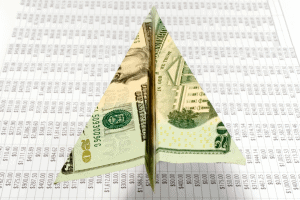Download the PDF copy here.
Economic Soft Landing Achieved
Please know that we are aware of the long length of these letters and the challenge it is to read them.
The letters are intended to keep you well informed, aware of what we are seeing and thinking, and an aid to help us clarify the economy and market for our decision-making. In addition to the Executive Summary, we attempt to provide a bold font or underlining for emphasis of key information as an option to shorten your reading time. There are a considerable number of key facts, analysis, and anecdotal evidence omitted from each of these reviews.
Executive Summary
- We have been writing about the threat of inflation and recession for about two years now. Enough already. The soft landing of the economy has occurred. The Federal Reserve’s restrictive policies have not led to a recession. They have reached a near-term peak in the Federal Funds Rate (FFR) and have employed Quantitative Tightening (selling bonds from their balance sheet to reduce money supply) to slow the economy and inflation. Simultaneously, industry has been able to bring supply in line with consumer demand. The FED has plans to become gradually less restrictive (via lower FFR and pausing the selling of bonds) later in 2024 through 2026.
- To paraphrase Mr. Alan S. Blinder, Former Vice-Chairman of the Federal Reserve (1994 – 1996) – From 2/21/24 Wall Street Journal. The Fed has already achieved a soft landing. Something could go wrong in the future, but we are already safely on the ground. As of December, the Fed’s preferred personal consumption expenditure inflation rate over the past twelve months, which in June 2022 was 7.1%, is now down to 2.6%. [Note: It is 2.4% as of January 2024.] That 2.6% rate, however, includes the 4% annualized inflation rate of the first quarter of 2023, which will fade out of the calculation within a few months. The annualized six-month PCE inflation rate is now 1.8%. The annualized three-month inflation rate is barely above zero. That is a strong downward trend. When we turn to the “soft” part, the performance is even better. The U.S. economy grew 3.2% in 2023, well above expectations. The unemployment rate has been below 4% for 25 consecutive months.
- Federal Reserve Chairman Powell has said officials want to see more evidence that inflation is returning to the Fed’s 2% goal (before reducing the Federal Funds rate). Incoming data “doesn’t need to be better than what we have seen, or even as good. It just needs to be good,” he said on “60 Minutes” in February. This is a nod to the six-month and three-month inflation data mentioned above.
- The attention of market observers is turning towards the timing of and number of times the Federal Reserve will reduce the Federal Funds rate in 2024. The Fed typically cuts interest rates because economic activity is slowing sharply, but in public comments, officials have turned their attention to scenarios under which they could lower rates even with solid economic growth. The corporate earnings recession has ended, profits are growing again, and the Federal Reserve looks as if it will start cutting rates sometime in the 2nd half of the year. For the stock market, this is a rare and potent combination where interest rates are lowered while the economy remains healthy. See the Federal Reserve Bank’s Forecast for the Federal Funds Rate in the Macro-Economic Perspectives section below. Three reductions of 0.25% are projected this year.
- Counter to the exciting prospect of lower interest rates and growing profit is the lofty valuations for stocks, especially growth stocks.
Macro-economic Perspectives
- The USA has now strung together six quarters of real GDP growth. Real growth is nominal growth less inflation. Q3 2022 was 3.2%. Q4 2022 was 2.6%. Q1 2023 was 2.0%. Q2 2023 was 2.4%. Q3 2023 was 4.9%. Q4 and the Year 2024 was 3.2%. GDP Now (Federal Reserve Bank of Atlanta) estimates that Q1 2024 real GDP growth will come in at 2.5%.
- The Federal Reserve Bank’s Federal Open Market Committee (FOMC) of twelve members provided their December forecast for change in Real GDP, unemployment rate, inflation, and the Federal Funds rate.
| FOMC December 2023 Forecasts Percent | 2023 | 2024 | 2025 | 2026 | Longer Run |
| Change in Real GDP, 4th Q to 4th Q | 2.6 | 1.4 | 1.8 | 1.9 | 1.8 |
| Unemployment Rate by Year End | 3.8 | 4.1 | 4.1 | 4.1 | 3.8 |
| Headline PCE Inflation, 4Q to 4Q | 2.8 | 2.4 | 2.1 | 2.0 | 2.0 |
| Core PCE Inflation, 4Q to 4Q | 3.2 | 2.4 | 2.2 | 2.0 | 2.0 |
| Federal Funds Rate | 5.4 | 4.6 | 3.6 | 2.9 | 2.5 |
| Implied Natural Interest Rate | 2.2 | 1.4 | 0.9 | 0.5 |
- Assuming Federal funds rate reductions of 0.25% each, the Fed is projecting three reductions in 2024, four reductions in 2025, and three reductions in 2026.
- The Fed’s projection for real GDP growth in the December meeting was decidedly below the actual result for 2023. They expect economic growth to weaken this year. This is likely the anticipated result of maintaining a higher implied Natural Interest Rate (the difference between the Federal Funds rate and inflation) in 2024. This results in higher real interest rates for borrowing relative to inflation. We will discuss the Natural Interest Rate implications in the Securities Market Perspective at the end of this letter.
- We experienced an earnings growth recession between Q4 2022 and Q2 2023. But earnings growth turned positive in Q3 2023 and appears to have been quite good in Q4 2023.
- Q2 2023 earnings growth was negative 5% year over year.
- Q3 earnings surprised with a growth of 4.8%.
- Q4 earnings growth (with 2/3 of companies reporting) is now seen at 9%.
- We are seeing projections for 2024 earnings per share growth between 4.5% and 11%. Early projections for earnings per share growth for 2025 are 15%.
- The velocity of money (the frequency at which one unit of currency is used to purchase goods and services within a given period) has risen from a bottom in Q2 2020 of 1.128 to 1.34 in Q4 2024 but is still historically very low when compared to the historical average of about 1.8. This remains counter-inflationary.
- Money Supply (M2 – cash, checking and savings deposits, money market mutual funds, and CDs). Despite Quantitative Tightening by the FED, money supply remains well above trend by at least $2 Trillion. Nominal M2 money supply remains profoundly supportive of consumer activity.
- Inflation: The Federal Reserve believes we are on track to achieve their target of 2% by 2026. We think inflation will hit the 2% target much sooner.
- PCE inflation was 2.4% in January 2024, which is the Fed’s forecast for 2024. The last six months annualized rate was 1.8%.
- PCE Core inflation (excluding food and energy) was 2.8% in January 2024. The last six months annualized rate was 2.28%.
- Why are Consumer Price Inflation (CPI) readings about 1% higher than PCE inflation? The CPI index weighting for housing or shelter is about 33% vs. 16% for the PCE. The housing component is based upon rental contracts which are typically updated once per year. This delays the new price information as compared to other component readings for inflation where prices are updated monthly. With the over-building of multi-family housing units’ rental rates are coming down. Also, rent equivalents of single-family homes are also declining as median home prices are down 8.4% since June 2023. The difference in CP and PCE will likely decline as rent and rent equivalent numbers are updated.
- Consumer financial well-being remains good and stable-ish. Credit card delinquency is rising but not scary. Revolving credit relative to GDP and disposable income is below 2019 trend.
- The personal savings rate has declined from 6.2% in 2019 prior to the pandemic, after rising to double-digit levels in 2020 and 2021. In the latter part of 2022 to the present, the savings rate has gradually slipped and was at 3.8% in January 2024. In total, inflation has slightly reduced consumers’ ability to save. But recent data analysis by the Commerce Department indicates that excess savings levels remain high at all income quintile levels.
- Beginning in January 2023 through January 2024, year over year real disposable income (after inflation) has risen every month.
- Year over year, real personal consumption expenditures, a comprehensive measure of consumer spending shows rising expenditures after adjusting for inflation throughout 2022, 2023, and continuing through January this year. February data has not been released yet.
- Household net worth reached $111.04T at the year-end 2019. Since then, it had risen to $142.3T at the end of 2021. At Q3 2022 end, it declined to $136.2T. It has since climbed back up $147.12T at 2023 year-end. Household net worth continues to be supportive of economic growth. Source: Federal Reserve.
- Bank delinquency rate on all loans and leases at all Commercial banks remains low at 1.38% through 2023 year-end. Most categories remain low and steady, except credit cards which rose from very low levels one year ago. At 3.10%, the credit card delinquency rate is the highest rate since the year-end 2011. But it is below the levels experienced between 1991 (when the Federal Reserve first recorded this data) and 2011 inclusive. For recent comparison, the rate was 2.62% at the end of 2019. Data from the Federal Reserve.
- Revolving consumer credit as % of disposable income and as % of GDP remains below pre-pandemic trend since the year-end 2019. This includes credit cards. Calculations by Vanguard with data from Federal Reserve and Equifax.
- Employment – There has been some cooling off in the labor market, which helps bring inflation down, but it remains strong. The average monthly job gains in 2023 was 230,000 per month.
- The unemployment rate rose from 3.4% in March 2023 to 3.9% in January 2024. Job openings have declined from a peak of 12,182,000 in March of 2022 to 8,863,000 in January 2024.This still accounts for a lot of unfilled jobs. The average level in 2017 through 2019 was 6.8 million. There are 1.43 openings per unemployed person.
- Christopher Waller, Member Federal Reserve Board of Governors, predicted that high labor demand and high labor vacancy rates (job openings) would enable the FED to increase rates beginning in 2022 without inducing a recession. He had many doubters at the time, but he has been proven correct. Last month, Mr. Waller cautioned against keeping rates too high for too long. The vacancy level of concern to Mr. Waller is 4.5%. Our calculations put that at 7,880,000 job openings. This is about 1,000,000 less than the reading just reported for January, 8,863,000.
- At the rate job openings have been declining, the concerning vacancy level would occur in about one year. Interesting to note that the FED is forecasting three Federal Funds Rate reductions this year. Coincidence? We think not.
- Macro-economic Summary (The consumer is strong but showing initial signs of weaking).
- Real GDP growth is particularly good.
- Corporate earnings growth has turned positive and projections for improvement are present.
- Real income has turned positive and real consumer spending is consistently rising.
- New research shows that excess savings remains remarkably high.
- The personal savings rate has been slipping.
- Labor supply is still tight but is loosening. Employment is strong.
- The labor participation rate has leveled off.
- Inflation is trending down, and FED’s readings of momentum are also pointing to lower inflation. Inflation is trending lower than FED projections.
- It appears that a soft landing of the economy has occurred. The FED sees inflation trends that point to Federal Funds Rate reductions in 2024. Rate reductions in a growing economy are a rare event.
Key Segments of the Economy
Consumer spending (70% of GDP): Year over year comparisons for each month have remained positive for 35 consecutive months through January 2024. The Institute of Supply Management (ISM) reading for services has remained above 50 each month for 45 consecutive months except December 2022. 50 is the dividing line between decline and growth. The services portion of the economy is very strong.
Manufacturing (11% of GDP): The ISM reading for manufacturing dropped below 50 in November 2022. It has remained below 50 through February 2024. This corresponds to the rush to rebuild inventory in late 2020 through mid-2022 only to find the need for inventory reductions at retailers beginning late 2022. The
effect of the pull ahead of consumer and durable goods demand during the Covid shutdown is still negatively impacting demand. Industrial production (includes mining, gas and electric utilities, and manufacturing) has been flat for 2023 and January 2024. The goods portion of our economy is in a slight recession.
Construction (4.1% of GDP): This data is not adjusted for inflation, but total $ spent on construction (residential and non-residential) has risen each month in 2023 through December and is up 14.4% year over year. Residential construction began a gradual decline in June 2022. This has slightly changed course in October 2023 with a 1% reduction in mortgage rates. This is welcome news given the shortage of existing homes for sale. But multi-family construction over-built in 2021 through mid-2023 and is beginning to decline rapidly. Non-residential construction is running hot with percentage gains in the high teens and low 20’s year over year each month in 2023 through January 2024. There is not any evidence of a slow-down in non-residential construction, not to mention reshoring efforts for CHIP manufacturing and Inflation Reduction Act projects. (Data from U.S. Census Bureau and Federal Reserve of St. Louis)
Home sales: The impact of high prices and high interest rates is being felt in existing and new single-family home sales. The National Association of Realtors (NAR) reported that combined existing and new home sales declined 35% from 6,929,000 in 2021 to 4,531,000 units in 2023. Mortgage data firm Black Knight reports that two-thirds of mortgages in place are under 4%. Further, 73% of primary mortgages have a fixed rate for 30 years. At present mortgage rates, existing home sales will remain depressed.
The supply of homes for sale has risen from 1.6 months in January 2022 to 3 months at the end of January 2024. Six months’ supply is considered a balanced marketplace for buyers and sellers. This increase in supply is due primarily to the overbuilding of multi-family housing units. The annual build rate for multifamily housing units dropped approximately 30+% year over year each month since August 2023.
Housing affordability is a significant issue. Additional housing supply is needed. The projected reductions in Federal Funds Rates in 2024 through 2026 will be very welcome. But FED projections for the Federal Funds Rate will not bring mortgage rate relief until 2025.
Securities Market Perspective
By the end of the year 2023, a 100% stock portfolio with 20% invested in international was up 22.55% with dividends reinvested. Intermediate term bonds (Bloomberg Aggregate Bond Index) and short-term bonds (Bloomberg U.S. Gov’t Credit 1 to 3 Year Bond Index) were up 5.53% and up 4.61%, respectively.
DBFM’s investment philosophy has always favored value stocks for their long-term result of higher return with less risk as compared to growth stocks. In addition, value stocks can be a good source for income production. In 2020, DBFM allocated approximately 25% of stocks to quality (companies with good balance sheets and profits) growth stocks given the impact of the economic shutdown due to Covid. Quality growth stocks performed well in the stay-at-home economy. This trend changed direction towards the end of 2020. At that point, DBFM eliminated allocations to growth funds in small cap and mid-cap asset classes. The trend towards better relative performance in value stocks spread to large cap in 2022 (value beat growth by 25.6%). As a result, we reduced but did not eliminate our allocation to large cap quality growth stocks in 2022.
Throughout 2023, it was the revenge of technology growth stocks, but the success was limited to a small basket of seven stocks (coined the Magnificent Seven): Apple, Microsoft, Alphabet, Amazon, Nvidia, Meta Platforms (Facebook), and Tesla. The Nasdaq was up 44.64% (with dividends reinvested) for the year. The S&P 500 was up 26.29% with dividends reinvested. Without the Magnificent Seven stocks, the S&P 500 return would have been 9.9% in 2023.
In a reversal from 2022, growth stocks outgained value stocks by 28.22% last year. Looking at returns for all of 2022 and 2023, value stocks outperformed growth stocks by 1.94%. These comparisons are on a weighted average basis (70% large cap, 20% mid-cap, and 10% small cap).
At the end of 2023, as measured by price to book value, growth stocks were 133% above their long-term average of 4.83 at 11.25. At the end of 2023, value stocks were 16% above their long-term average of 2.03 at 2.36. Price/earnings ratios (the price paid for $1 of earnings/share) for growth stocks and value stocks were 33 and 15.7, respectively.
Fixed Income: On page 2, we promised to discuss the implications of the FED’s forecasted (higher) natural interest rate. The natural interest rate (also known as the real neutral rate of interest) is the designed difference between inflation and the Federal Funds rate of interest. It is an estimate of a rate needed to achieve full employment and stable inflation. Historically, as the US economy had grown significantly, this rate had hovered at or above 2%. After the financial crisis, the natural rate was estimated to be about 0.5%. In the Federal Reserve’s December 2023 forecast, the FED estimated that inflation would reduce back down to 2% by 2026. But the Federal Funds rate would be 2.9%, thereby implying a natural rate of 0.9%. And in 2025 there is an implied natural rate of 1.4%. So, we do not know if this is part of their process of “jawboning” inflation down or if they genuinely believe an increase in the natural interest rate is appropriate. In the longer run, the FED is forecasting a return to a 0.5% natural interest rate. Vanguard Capital Markets
(VCM) expects rates to settle at a higher level (higher natural interest rate). In a nutshell, VCM explains that drivers of higher interest rates are an aging population where retirees spend their savings. At the same time, the working-age population will shrink. The government will borrow to finance infrastructure and other
long-term needs. So, as fewer people are saving and more are borrowing, interest rates will rise. The FED’s longer-run projection of returning to a lower natural interest rate contrasts with VCM’s expectation of a natural rate of 1.5%.
The near-term and intermediate-term stopping point for the Natural Interest Rate is an especially important factor to consider in shifting from short-term bonds to intermediate-term bonds. In 2023, DBFM had been very reluctant to move out of short-term bonds into intermediate-term bonds when intermediate-term interest
rates were low by any of the new estimates of the natural rate.
DBFM avoided much of the intermediate-term bond blood bath in 2022 by positioning in short-term bonds and short-term bond funds. We continued to do so in 2023 and have created timed windows to give us the option whether to extend duration (move towards intermediate-term bonds). In the meantime, we are reaping excellent yields in short-term bonds. But we have also begun to gradually move into intermediate bonds as 10-year yields have risen.
Wrap-Up
Black swans aside, we see evidence of inflation declining towards the FED’s 2% target, some cooling in a still strong labor market, while the consumer and economy remain resilient. We believe that a soft landing of the economy from the monetary policy constrictions has occurred. Prior to the FED lowering the Federal Funds Rate (FFR) in the latter half of the year, lower inflation will result in more restrictive monetary policy in real terms (FFR – inflation). The stock market will witness a potent combination of a growing economy, growing corporate earnings, and lower interest rates in the latter half of the year. This potency will likely be tempered by the present high valuations, especially for growth stocks.
The higher natural rate of interest will result in higher borrowing rates than we have been used to prior to 2022 and 2023. Vanguard refers to this as a return to sound money which has its own set of implications. Saving becomes more attractive. Speculative investing would become less attractive. Businesses become more judicious with capital allocation. Smaller leveraged companies become more vulnerable. For federal governments, higher interest rates force a reassessment of fiscal policy.
As always, we remain long-term bullish, seeking necessary or opportunistic tactical adjustments to portfolios, and remain diversified for long-term success.
Please feel free to contact us with any questions, or if you would like to schedule a face-to-face, virtual, or phone meeting.
Thank you,
Dave Dickmeyer, M.B.A.
Wealth Advisor
Principal Owner
Ian D. Boyce, CFP®
Certified Financial Planner™
Principal Owner
Drew Lanphear, CFP®, RICP®
Certified Financial Planner™
Director Wisconsin Office








